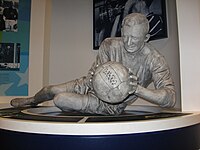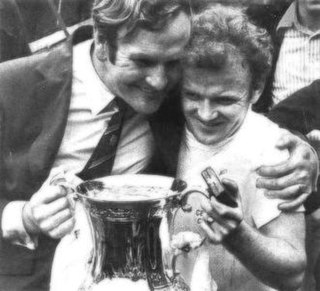Post war (1946–1964)
Former captain Cowan takes over and gains promotion (1946–47)
When play resumed after the war, Cowan became Manchester City manager in November 1946, succeeding Wilf Wild, who moved to a purely administrative role. [14] Cowan had been known for his motivational skills as a player, and was part of a new generation of managers who took responsibility for tactics and team selection, of which Cowan's contemporary and former defensive teammate at City Matt Busby became the most well-known.
Cowan was given a salary of £2,000, and came to an agreement whereby he spent part of the week with the Manchester City team and part looking after his business interests in Brighton. [15] His first match as manager was a 3–0 win against Newport County, and the team then embarked upon a run of 19 matches without defeat. Despite achieving the division Two title in his first season in charge, Cowan resigned in June 1947 as his commute from Brighton caused tension with club officials. [16] His resignation was perhaps unfortunate, despite City having a post-war squad far capable of being in the second tier of English football, as former captain he impressed as a young manager and as of 2010 has the highest win percentage of any City manager in history.

There have only been two world-class goalkeepers. One was Lev Yashin, the other was the German boy who played in Manchester – Trautmann.
Bert Trautmann (1949–1964)
The club courted controversy in 1949 by signing German goalkeeper Bert Trautmann as a replacement for England international Frank Swift, who had retired. [17] Trautmann's story with Manchester City and importantly the English supporters was soon inscribed in English football folklore and it is hard to think of a footballer who has been on such a life journey. [18]
Previously being a Nazi paratrooper Trautmann admitted during and prior the war he saw the British and Jews as enemies, however it was when he taken as a prisoner of war in England that he quickly reappraised his view of both. He was astonished at his treatment as a POW, after being invited for Christmas dinner, an unthinkable luxury in an brainwashing, dictatorial Nazi Germany. [18] Trautmann soon warmed to England that he decided to settle in the country upon repatriation in Lancashire and even changed his name from the hard to pronounce Bernhard to a more English Bert. Having taken an interest in sport, he soon played for St Helens Town and humbled when Manchester City signed him in 1949. [19]
The signing sparked protests; 20,000 people attended a demonstration. [20] Furthermore, there was pressure on Trautmann himself as he had to replace Frank Swift, still regarded as one of the greatest goalkeepers of all time [2] as well as one of the most popular with his genial, gentlemanly manner. [19] He also gained support from a Jewish rabbi who said "not only one man can be convicted representative for one country" and Trautmann should not be prejudged. [21]
Remarkably his dissenters soon changed their tone with his stellar performances, in an often struggling Manchester City when he first joined. [21] His bravery to claim a loose ball often at the peril of an oncoming opponent at full speed was admired by many supporters, not only City supporters. [22] It was this technique that gave him a broken neck in the 1956 FA Cup Final and had to play the last 15 minutes as no substitutes were left. Regardless of this event, Trautmann was already seen as a hugely popular figure in English football and by the end of career with City he was lauded as one of the greatest goalkeepers of all time with 47,000 people attending his testimonial, [23] with estimates at closer to 60,000. [24]








